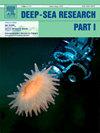南极半岛北部Gerlache海峡悬浮颗粒物的分布、组成和驱动因素
IF 2.1
3区 地球科学
Q2 OCEANOGRAPHY
Deep-Sea Research Part I-Oceanographic Research Papers
Pub Date : 2025-07-24
DOI:10.1016/j.dsr.2025.104559
引用次数: 0
摘要
研究了2020年南夏南极半岛北部沿海生产区Gerlache海峡悬浮颗粒有机碳(POC)、稳定碳同位素(δ13C-POC)和悬浮总颗粒氮(PN)的生物地球化学组成和空间分布。本文研究了与海冰融水输入、浮游植物群落组成和水体质量分布相关的分布模式,旨在确定水柱中颗粒组成和δ13C-POC特征的主要驱动因素。结果表明,不同的物理-生物过程影响了格拉赫海峡表层和中上层(100-800 m) POC、PN和δ13C-POC的生物地球化学动力学。地表悬浮颗粒表现为自养生产,由于季节性有机质生产和浅层积(<20 m)而积累。低盐度条件下,表层POC (>10 μmol L−1)、PN (>2 μmol L−1)和叶绿素-a (>2 mg m−3)浓度较高,强调了融水输入对有机质生产的作用。此外,我们的研究结果表明,浮游植物群落组成对形成表面δ13C-POC特征和POC/PN比率的影响与细胞大小和几何形状的差异一致。在中上层,颗粒组成的变化与研究区水团的分布有关。旧变质环极深水侵入使较轻碳同位素(12C)和氮优先再矿化,导致δ13C-POC和POC/PN比值升高。相反,高盐度陆架水——最近从威德尔海大陆架通风平流到Gerlache海峡东北部的水团——显示出与地表水中观察到的颗粒化学成分相似。本文章由计算机程序翻译,如有差异,请以英文原文为准。
Distribution, composition, and drivers of suspended particulate organic matter in the Gerlache Strait, Northern Antarctic Peninsula
The biogeochemical composition and spatial distribution of suspended particulate organic carbon (POC), its stable carbon isotope (δ13C-POC), and suspended total particulate nitrogen (PN) were investigated during the austral summer of 2020 in the Gerlache Strait, a productive coastal area of the Northern Antarctic Peninsula. This study addressed the distribution patterns relative to sea ice meltwater inputs, phytoplankton community composition, and water masses distribution, aiming to identify the primary drivers of particle composition and δ13C-POC signatures in the water column. The results showed that distinct physical-biological processes influenced the biogeochemical dynamics of POC, PN and δ13C-POC across the surface and mesopelagic layers (100–800 m) in the Gerlache Strait. Surface suspended particles indicated an autotrophic production and has been accumulated due the seasonal organic matter production and shallow stratification (<20 m). Higher surface concentrations of POC (>10 μmol L−1), PN (>2 μmol L−1) and chlorophyll-a (>2 mg m−3) were found at low salinity conditions emphasising the role of meltwater input on organic matter production. Additionally, our findings suggested the influence of phytoplankton community composition on shaping surface δ13C-POC signatures and POC/PN ratios, consistent with differences in cell size and geometry. At the mesopelagic layer, particle composition variations were associated with the distribution of the water masses in the studied region. Intrusions of old modified-Circumpolar Deep Water contributed to increase the δ13C-POC and POC/PN ratios, due to preferential remineralisation of the lighter carbon isotope (12C) and nitrogen. Conversely, High Salinity Shelf Water – a water mass recently ventilated and advected from the Weddell Sea continental shelf to the northeast sector of the Gerlache Strait – showed a particle chemical composition like that observed in the surface waters.
求助全文
通过发布文献求助,成功后即可免费获取论文全文。
去求助
来源期刊
CiteScore
4.60
自引率
4.20%
发文量
144
审稿时长
18.3 weeks
期刊介绍:
Deep-Sea Research Part I: Oceanographic Research Papers is devoted to the publication of the results of original scientific research, including theoretical work of evident oceanographic applicability; and the solution of instrumental or methodological problems with evidence of successful use. The journal is distinguished by its interdisciplinary nature and its breadth, covering the geological, physical, chemical and biological aspects of the ocean and its boundaries with the sea floor and the atmosphere. In addition to regular "Research Papers" and "Instruments and Methods" papers, briefer communications may be published as "Notes". Supplemental matter, such as extensive data tables or graphs and multimedia content, may be published as electronic appendices.

 求助内容:
求助内容: 应助结果提醒方式:
应助结果提醒方式:


